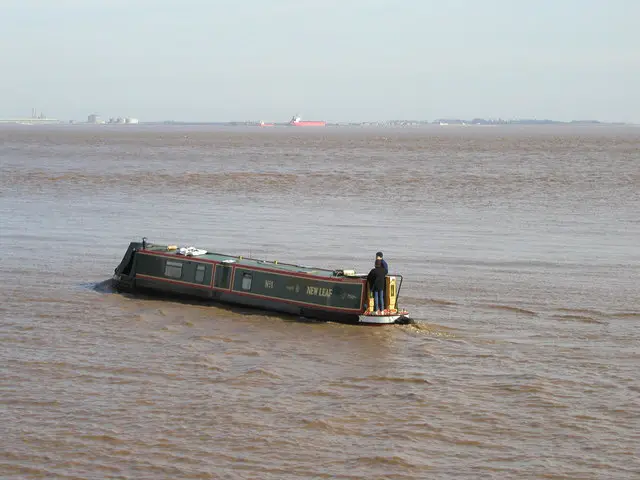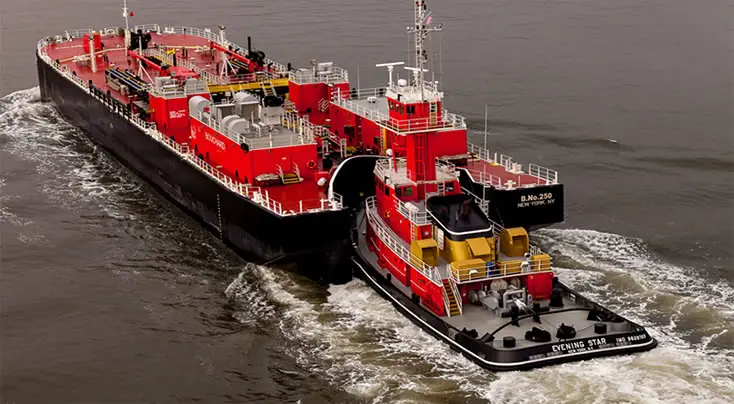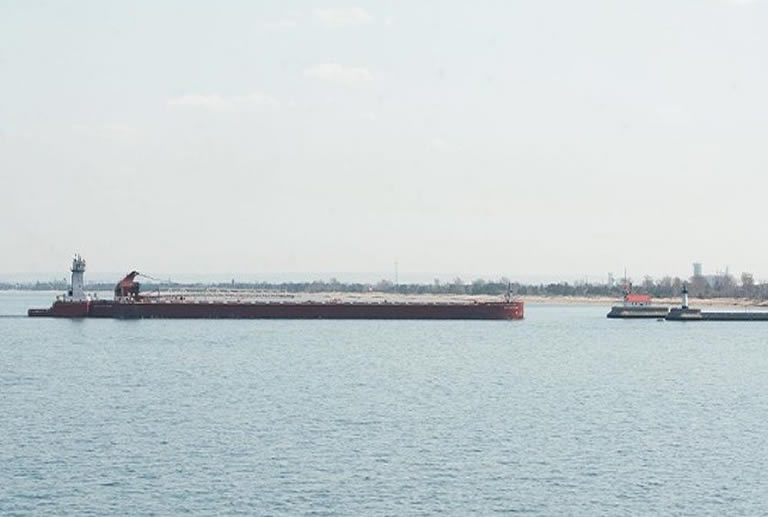Barges are flat bottom vessels that are seen mostly on inland waters. They are common sights along canal networks and some rivers thus having the name canal boat in many countries. Barges can be large working boats or smaller personal vessels. But many people wonder if it is safe to take a barge out into the ocean.
Contents
Safety Issues Of Using A Barge At Sea
Can a barge go on the sea?
Barges are designed to be used on shallow inland waters. They are not considered sea-worthy watercraft due to their flat bottom hull and shallow draft.
However, there are commercial ocean-going barges that are used along coastal routes.
Smaller personal barges, like a narrowboat, can be taken out to sea but only under very specific conditions.
These boats are not designed for rough water and should only ever be used in open waters under optimal weather conditions, if at all.
A barge can be taken to the sea when the weather is calm and there are no large waves. However, it is not advised.
Canal boats are not designed for sea use
Most small barges are known as canal boats because they are usually used in canals rather than in open waters or even in rivers or lakes.
Due to the flat bottom hull design a canal boat is perfect for the type of shallow water you often encounter in a canal, especially in Europe and the British Isles.
But, because many people will take a Jon boat into the ocean it is not unreasonable to ask the question can you take a canal boat on the sea.
British canal boats were used in the sea in WWII but only once & for a very important reason
Narrowboats are smaller personal barges that are most often seen on the British, Irish and European canal networks. Although they can also be seen on some European rivers they are first and foremost canal boats.
These flat-bottomed barges are long, narrow and have a very shallow draft. This makes them ideal for use on the very shallow canal networks of the British Isles, for which they were designed, but unsuitable for use in turbulent ocean waters.
As I mentioned above the wider a flat bottom boat is, the more stable it is. Narrowboats are exactly what their name implies – narrow.
This therefore greatly reduces their stability.
Narrowboats are designed for British and Irish canals that are narrow and very shallow.

These canals are also located inland and so experience very little chop, if any at all.
This means a narrowboat does not need to have superior stability as it will float very comfortably in a calm canal.
Most modern narrowboats are holiday vessels that are used for cruising slowly along inland canals. They are not designed to be used in the sea.
Does this mean you can’t take a narrowboat or similar personal barge out to sea?
No, it doesn’t. Personal barges have been used in the sea but only under very specific conditions.
Can you take a narrowboat on the sea or across the English Chanel?
You can take a narrowboat across the English Chanel but only under strict conditions.
Some guys have sailed their narrowboats across the English Channel between England and France. Though they only did it on a very clear, calm day as any sea body would quickly sink a barge in anything but calm weather.
It is said narrowboats were used during the evacuation of Dunkirk as part of Operation Dynamo.
This is when 330,000 Allied troops were trapped on a beach at Dunkirk when they were pinned down by Nazi forces.
It looked certain that they would be annihilated as they had no form of escape and the British navy was unable to rescue them all in time.
So 850 personal British vessels from fishing boats to yachts and rowboats to narrowboats, all manned by civilians, sailed across the English Chanel to rescue the troops.
So does this prove that narrowboats can be used in the sea?
Can you take a narrowboat or other canal boat on the sea?
Yes … and no!
Let’s see what I mean by that answer.
The trouble with taking barges to the sea
On face value when we review the events from the evacuation of Dunkirk, it seems that narrowboats can be used in the sea. But the evacuation of Dunkirk doesn’t tell us the whole story about a barges ability to handle the open sea.
It should be noted that during the evacuation of Dunkirk the weather in the English Chanel was unusually calm! Had it not been, hundreds of those vessels would likely have sunk and the miracle that is Dunkirk would have turned out very differently.
So, my point is this:
You can use a small personal barge, like a narrowboat, in the sea but only in completely optimal weather. Challenging weather and rough waves will sink the boat.
Most barges are narrow vessels that have a very shallow draft because they are designed to be used on canals and rivers.
The first barges were used in ancient Egypt as pleasure boats, ceremonial vessels and to haul freight down the Nile, which has notoriously submerged banks all along its length that have sunk, and continues to sink, boats even today.
As we covered in the article shallow draft vs deep draft, a boat used on inland waters needs to have a shallow draft so it can be used to navigate shallows that are prevalent in inland waters.
Conversely, boats that sail on ocean waters need a deep draft so they have stability in deeper more turbulent waters.
This is why most river boats will have a shallow draft while most sailing boats and ocean-going ships will have a deep draft (with the exception of a shoal draft boat).
The Ocean Barge Is The Exception To The Rule
Although there are barges that are used in open ocean waters they are not seaworthy vessels.
Ocean-going barges are used in very specific ways and have been modified for the marine environment in which they are used.
This is because the barge was never designed for ocean use. In fact, the barge wasn’t even designed to be used in deep water.
However, there are barges that are used in the ocean with the most common type being commercial tug barges.
A tug barge is an ocean going barge (of sorts)
Commonly when you see a commercial barge at sea it will be a tug barge.
Commercial tug barges are used along coastal routes between coastal cities for hauling bulk freight.
A tug barge is a large flat-bottomed vessel that has no propulsion of its own but is pulled and pushed to its destination via tug boat.

These large boats are used in coastal areas and are most common in North America along coastal routes between coastal cities.
As the barges are used in open water, that is more turbulent than the boat was designed for, these vessels have evolved from the narrow shallow draft barge to a boat that is wider and that sits deeper in the water.
This gives the tug barge a deeper draft and more stability in the water. Widening a flat bottom boat makes it more stable (hence the introduction of the double wide Jon boat) .
The customizations have made to these tug barges so they can be used in waters with waves up to 20 feet – waves that would normally sink a flat bottom vessel.
Now, just because a tug barge is capable of being used in coastal ocean waters that doesn’t mean it can be used out in the deeper, more turbulent parts of the ocean. It can’t.
If you were to take a tug barge on a trip across the Atlantic, for example, you may make it, but chances are you won’t.
This is still a flat bottom boat with all the disadvantages that come with that as far as open water goes.
Summary: Why You Shouldn’t Use A Barge At Sea
Unless you are planning to take to the ocean in a tug barge, and you only intend to stay to coastal areas, it is not a good idea to take your barge into the sea!
As barges were designed to be used on narrow, and very shallow canals, they tend to be narrow vessels with shallow drafts. What they lose in width they make up for in length.
Barges were designed to be working boats used mostly for hauling freight. To fit the greatest amount of freight onto the barge it needed to be made longer as it was not possible to make it wider. This design makes a barge very unstable in choppy water.
Although barges are not designed for sea use some people do tempt fate and take them into ocean waters.
If you intend to use a barge in the sea you must take the proper precautions.
This type of flat bottom, shallow boat was never designed for ocean use and is not seaworthy.
Even the ocean-going tug barges mentioned above stick to coastal areas and they have been heavily modified to make them more stable. If these boats were taken out to sea they would sink in the first storm.
You can only take a personal barge, like a narrowboat, into the ocean when the weather is optimal and you have taken extreme safety precautions.
Ideally you should stick to coastal routes keeping the coastline within sight at all times.
Obviously if you are intending to boat across the English Chanel or similar body of water this will not always be an option.
So it is imperative that the weather and water are calm and will remain so for the duration of your journey.
As a final word I would like to state quite clearly that it is not advisable to take a narrowboat into ocean waters.
They are just not designed for it and are probably the worst type of boat you could use with maybe the exception of an airboat!

